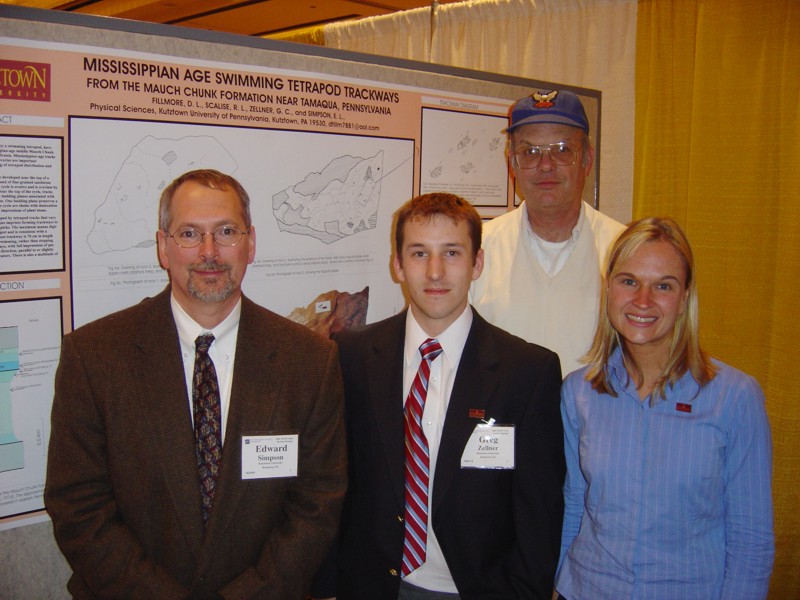
 Mississippian-Age
Swimming Tetrapod Trackways from the a Mauch Chunk Formation
Near Tamaqua, Pennsylvania
Mississippian-Age
Swimming Tetrapod Trackways from the a Mauch Chunk Formation
Near Tamaqua, Pennsylvania
Fillmore,
D.L., Scalise, R.L., Zellner, G.C., and Simpson,
E.L., 2004 [abs]: Mississippian-Age
Swimming
Tetrapod
Trackways
from
the
a Mauch Chunk Formation Near Tamaqua, Pennsylvania,
Northeastern Section (39th Annual) and Southeastern Section (53rd
Annual) Joint Meeting (March 25–27, 2004), Abstracts with Programs,
Vol. 36, No. 2, p. 109.
 New tracks and trackways, made by a
swimming tetrapod, have been recovered from the Mississippian-age
middle Mauch Chunk Formation near Tamaqua, Pennsylvania.
Mississippian-age tracks and trackways are rare. Any discoveries are
important contributions to our understanding of tetrapod
distribution and behavior.
New tracks and trackways, made by a
swimming tetrapod, have been recovered from the Mississippian-age
middle Mauch Chunk Formation near Tamaqua, Pennsylvania.
Mississippian-age tracks and trackways are rare. Any discoveries are
important contributions to our understanding of tetrapod
distribution and behavior.
The new tracks and trackways are developed near the top of a
fining-upward fluvial cycle composed of fine-grained sandstone
followed by shale. The base of the cycle is erosive and is overlain
by low-angle trough cross bedding. Near the top of the cycle, tracks
and trackways are present on two bedding planes associated with
preserved linguiod ripple bedforms. One bedding plane preserves a
larger dune bedform. Capping the cycle are shales with desiccation
cracks, raindrop impressions and impressions of plant stems.
The 70 by 115 cm rock slab is capped by tetrapod tracks that vary in
preservation from manus and pes imprints forming trackways to
preserved randomly oriented toe picks. The maximum manus digit span
is 3.9 cm. Digit IV is the longest and is consistent with a tetrapod
interpretation. The longest trackway is 70 cm in length and is
composed of 10 tracks. A swimming, rather than stepping pattern, is
indicated. The trackways, with full impressions of pes and manus,
progress in the same direction, parallel to or slightly oblique to,
the paleocurrent indicators. There is also a multitude of randomly
oriented toe picks.

 Mississippian-Age
Swimming Tetrapod Trackways from the a Mauch Chunk Formation
Near Tamaqua, Pennsylvania
Mississippian-Age
Swimming Tetrapod Trackways from the a Mauch Chunk Formation
Near Tamaqua, Pennsylvania 
 Mississippian-Age
Swimming Tetrapod Trackways from the a Mauch Chunk Formation
Near Tamaqua, Pennsylvania
Mississippian-Age
Swimming Tetrapod Trackways from the a Mauch Chunk Formation
Near Tamaqua, Pennsylvania  New tracks and trackways, made by a
swimming tetrapod, have been recovered from the Mississippian-age
middle Mauch Chunk Formation near Tamaqua, Pennsylvania.
Mississippian-age tracks and trackways are rare. Any discoveries are
important contributions to our understanding of tetrapod
distribution and behavior.
New tracks and trackways, made by a
swimming tetrapod, have been recovered from the Mississippian-age
middle Mauch Chunk Formation near Tamaqua, Pennsylvania.
Mississippian-age tracks and trackways are rare. Any discoveries are
important contributions to our understanding of tetrapod
distribution and behavior.